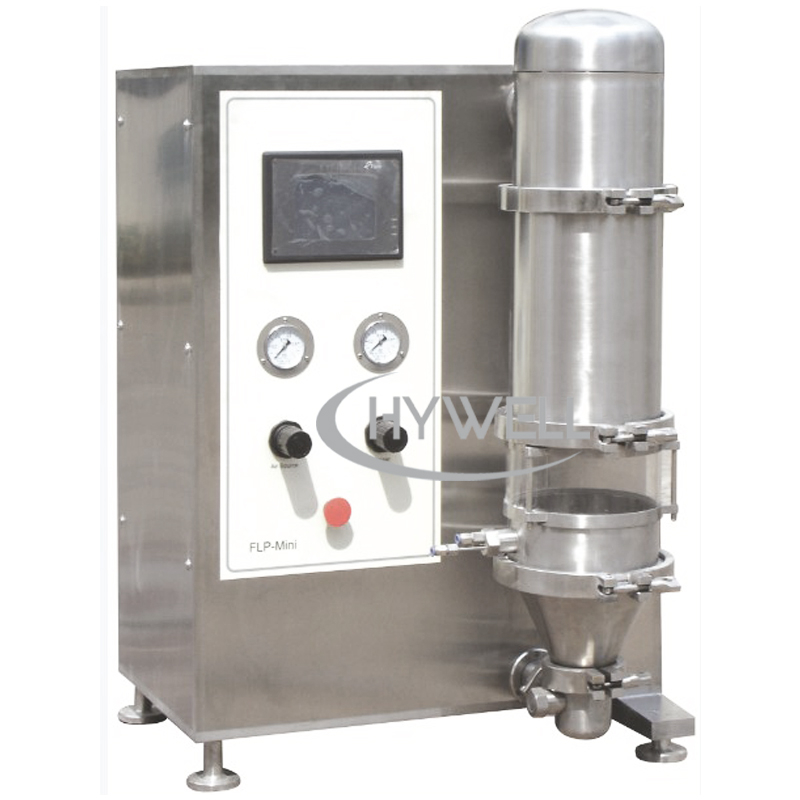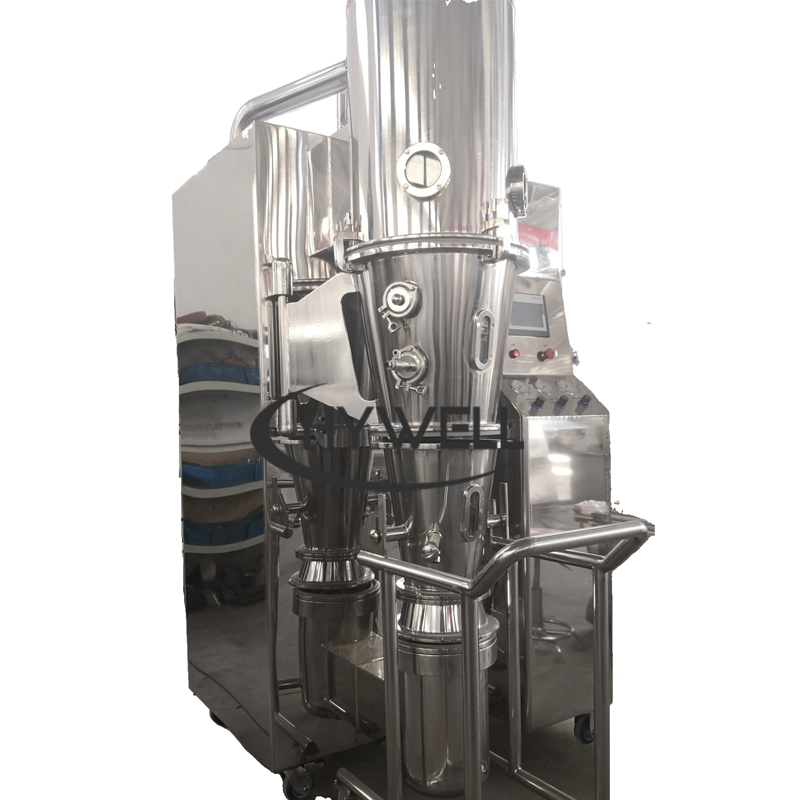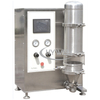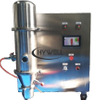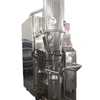Lab Fluid Bed Granulator Introduction
The lab fluidized bed granulator use liquids containing solids, such as solutions, suspensions, or melts, are sprayed into a lab fluidized bed system. Due to the high heat exchange, the aqueous or organic solutions evaporate immediately, and the solids form small particles as starter cores. These are sprayed with other liquids which, after evaporation, form a hard coating around the starter core.
This step is continuously repeated in the fluidized bed granulator so that the granulate grows layer by layer like an onion. Alternatively, a defined volume of suitable starter cores can be provided. In this option, the liquid only serves as a vehicle for the solids that are being applied.
This process variant is often used in a continuous lab fluid bed system with air-classifying discharge. Through the constant removal of the finished granules from the drying room, the amount of particles in the fluidized bed remains constant.
The granules can be very dense because they have grown in layers, and are thus resistant to abrasion. Parameters such as particle size, residual moisture, and solids content can be specifically adapted in order to achieve the most varying product properties. Using spray granulation, medium-sized particles of 50 micrometers to 5 millimeters can be produced.
The Laboratory Fluid Bed Granulator is also used as the dryer function, it is named the Lab fluid bed dryer granulator.
Hywell Machinery also has industrial fluid bed granulator from 15kg to max 500 kg if high-volume fluid bed granulators are required.
Video of Lab Fluid Bed Granulator
Working Principle of Lab Fluid Bed Granulator
The fluid bed granulation process consists of several stages. Initially, the granulation materials are fluidized by passing air or gas through a porous membrane, creating a fluidized bed. This fluidized state provides excellent contact between the particles, facilitating uniform distribution and optimal agglomeration.
Once the fluidization is established, the granulation solution is sprayed onto the fluidized bed, resulting in the formation of granules. The sprayed solution can contain binding agents, active ingredients, or other additives depending on the desired properties of the final product. The granules continue to grow as the moisture from the solution evaporates during the drying stage.
Additionally, fluid bed granulators can be utilized for coating applications. By introducing a coating solution onto the fluidized bed, a uniform and controlled coating layer can be achieved, enhancing the properties of the granules.
Lab Fluid Bed Granulator Video
Laboratory Fluid Bed Granulator Specifications
Model | unit | 1 | 3 |
Tank | Volume | L | 5 | 12 |
Diameter | mm | 80 | 300 |
Load capacity | Min | Kg | 0.8 | 2 |
Max | Kg | 1.5 | 4 |
Air volume | Air volume | M3/h | 5 | 25 |
Air pressure | Mm H2o | 480 | 480 |
Power | Kw | 0.75 | 3 |
Electrical Heater | Kg/h | 1.5 | 12 |
Compressed air consumption | M3/Min | 0.2 | 0.2 |
Weight | Kg | 200 | 350 |
1.Hywell machinery reserves the right to the design without notice 2.All specifications are as accurate as is reasonably possible, but they are not binding. |
Applications of Lab Fluid Bed Granulator
Pharmaceutical Industry
In the pharmaceutical industry, lab fluidized bed granulators play a crucial role in the production of tablets and capsules. The granules produced through fluid bed granulation exhibit excellent flowability and compressibility, making them ideal for tableting. Furthermore, the uniform distribution of API within the granules ensures consistent drug content in each dosage form.
Chemical Industry
lab Fluid bed granulators are widely used in the chemical industry for the production of granular materials. They are employed in processes such as fertilizer manufacturing, catalyst production, and specialty chemical synthesis. The ability to control the granule properties enables chemical manufacturers to meet specific product requirements and achieve desired performance characteristics.
Food Industry
In the food industry, laboratory fluid bed granulation finds application in processes like instant coffee production, encapsulation of flavors, and coating of food ingredients. By utilizing fluid bed granulators, food manufacturers can enhance product stability, improve flavor release, and create attractive texture and appearance.
Advantages of Laboratory Fluid Bed Granulator
Fluid bed granulators offer numerous advantages over traditional granulation techniques. Some of the key benefits include:
Efficient and Uniform Granulation
Lab fluid bed dryer granulators ensure uniform distribution of granulation solution, resulting in homogeneous granules with consistent size and shape. This is particularly crucial in industries where product quality and performance are critical factors.
Enhanced Drying Capabilities
The fluid bed granulation process inherently incorporates a drying stage, eliminating the need for separate drying equipment. The efficient heat transfer within the fluidized bed promotes rapid drying, reducing processing time and energy consumption.
Controllable Process Parameters
Fluid bed granulators offer the advantage of controllable process parameters, allowing manufacturers to optimize the granulation process according to their specific requirements. Parameters such as fluidization velocity, spray rate, and drying temperature can be adjusted to achieve the desired granule characteristics.
Versatility in Applications
Laboratory Fluid bed granulators find application in various industries, including pharmaceuticals, chemicals, and food. They can be used for the granulation of active pharmaceutical ingredients (APIs), production of agglomerates, and coating of particles. The versatility of fluid bed granulation makes it a valuable tool in different manufacturing processes.
Lab Fluid Bed Granulator Description
Heated and purified air flows into the column by a suction fan, the pellet or powder will be in uniform fluid condition inside the column, use one set of filter bags to prevent the leak of powder, and discharge the evaporated water to get drying purposes. If add one more spray gun can spray the binder or active ingredient downward into the uniform fluid powder, whenever the powder combined in granules will be dried to get the required moisture content.
Laboratory Fluid Bed Granulator
The lab top-spray granulator agglomerates finer particles into larger, free flowing granulates in a one-pot process. Ingredients are mixed and preheated by an upward flow of heated air. Granulation occurs by spraying liquid into the fluidized powder. The granules are subsequently dried with heated air. The top-spray granulator can also be used for top-spray coating, layering from liquids and instantizing. Special features include a selection of air distributors and one-pot processing.
Drying of Lab Scale Fluid bed granulator
Warm air is blown through a perforated distributor to rapidly and gently dry the formulation until the required residual moisture content is reached. Moisture evaporated from the product is exhausted with the drying air. Special features include a selection of air distributors and short processing times.
Lab Fluid Bed Granulators Construction Material
Hywell Machinery is able to offer our FL series lab scale fluid bed granulators with contact parts to be built in SS304, SS316L, Titanium, Duplex stainless steel, etc. For the control system of Laboratory scale fluid bed granulators, Hywell machinery has choices on push button, PLC+HMI, and so on, and For the main electrical components of the fluid bed dryer granulator, it can choices the famous brand.
How do the Lab Fluid Bed Granulator works
In a Hywell machinery lab FL series fluid bed granulator, The powder granule in a vessel (fluid bed) appears in the state of fluidization. It is preheated and mixed with clean and heated air. At the same time, the solution of adhesive is sprayed into the container. It makes the particles become granulating that contain adhesive. Being of unceasingly dry through hot air, the moisture in the granulating is evaporated. The process is carried out continuously. Finally, it forms ideal, uniform, and porous granules.
Lab Fluid Bed Dryer Granulator Feature
Hywell machinery lab fluid bed dryer granulator had the following advantages over conventional solutions.
1. Use for both drying and granulating processes.
2. Inlet air temperature probe.
3. Product temperature probe (optional).
4.100-micron screen (screens of different sizes upon request).
5. This machine adopts PLC automatic control, all the operations according to the requirements of the user to set the process parameters automatically, it can print all the process parameters (optional), and the original record is true and reliable.
6. Highly polished inner and outer surfaces of the barrel, no dead comer, easy to discharge materials, easy to clear, no cross-contamination.
7. The lab fluid bed dryer granulator has an enclosed structure, without overflow of power dust
8. The lab fluid bed dryer granulation have smooth running, reliable performance, and easy operation.
9. The processes of mixing, granulation, and drying are completed in one step inside the machine.
10. Repeated cartridge filter cleaning by compressed air counterblows while drying or granulation processes keep taking place.
11. Easy and quick filter disassembling.
Selection and Design Considerations
When selecting a lab fluid bed dryer granulator, several factors should be taken into consideration:
Production Capacity
The lab fluid bed spray granulator should be chosen based on the required production capacity to ensure optimal throughput.
Granule Characteristics
The desired granule properties, such as size, density, and porosity, should align with the capabilities of the granulator.
Process Flexibility
The spray liquid fluid bed granulator should provide the flexibility to adjust process parameters to accommodate different materials and formulations.
Cleaning and Maintenance
Consideration should be given to the ease of cleaning and maintenance procedures to minimize downtime and ensure product integrity.
Maintenance and Troubleshooting
Regular maintenance is essential to ensure the smooth operation and longevity of lab fluid bed granulators. Some common maintenance procedures include:
Cleaning of the granulator components, such as the product container, spray nozzles, and filters, to prevent product cross-contamination.
Inspection and replacement of worn-out or damaged parts, such as air distribution plates and seals, to maintain optimal performance.
In the event of issues or troubleshooting requirements, it is important to consult the manufacturer's guidelines or seek professional assistance to address specific problems effectively.
Future Trends in Lab Fluid Bed Granulation
The field of lab fluid bed granulation continues to evolve with advancements in technology and equipment. Some future trends to watch out for include:
Integration of process monitoring and control systems, enabling real-time data analysis and optimization of process parameters.
Development of advanced granulation techniques, such as twin-fluid atomization and hot melt granulation, to expand the range of applications and improve process efficiency.
Adoption of smart sensors and automation, enhancing process reliability and facilitating seamless integration with other manufacturing systems.
Conclusion
Laboratory Fluid bed granulators have emerged as indispensable tools in the pharmaceutical and chemical industries, offering efficient granulation and drying capabilities. With their ability to produce uniform granules, control process parameters, and cater to diverse applications, fluid bed granulators contribute significantly to the manufacturing of high-quality products.
FAQs
What is the difference between lab fluid bed granulation and other granulation techniques?
Fluid bed granulation differs from other granulation techniques in its ability to simultaneously fluidize, granulate, and dry the particles, leading to efficient and uniform granule formation. Unlike traditional methods like high-shear granulation or roll compaction, fluid bed granulation eliminates the need for separate drying processes and offers greater control over the granulation parameters.
Can laboratory fluid bed granulators be used for coating applications?
Yes, lab fluid bed granulators can be utilized for coating applications. By introducing a coating solution onto the fluidized bed, a uniform and controlled coating layer can be achieved, providing functionalities such as taste-masking, moisture protection, or controlled release of active ingredients.
How can I optimize the drying process in a laboratory fluid bed granulator?
To optimize the drying process in a laboratory fluid bed granulator, it is essential to control the inlet air temperature, airflow rate, and bed height. These parameters influence the drying efficiency and should be adjusted based on the moisture content of the granulation materials and the desired moisture level in the final product.
Are there any limitations to laboratory fluid bed granulation?
While laboratory fluidized bed granulation offers numerous advantages, it also has some limitations. For instance, it may not be suitable for materials that are highly sensitive to heat or have poor fluidization characteristics. Additionally, the size range of granules that can be produced may be limited compared to other granulation techniques.
What are some key factors to consider when purchasing a lab fluid bed granulator?
When purchasing a lab fluid bed granulator, key factors to consider include production capacity requirements, granule characteristics needed for the desired application, process flexibility, ease of cleaning and maintenance, and availability of advanced features such as process monitoring and control systems.
English
Русский
العربية
Français
Español
Português
Deutsch
italiano
日本語
한국어
Nederlands
Tiếng Việt
ไทย
Polski
Türkçe
ພາສາລາວ
Bahasa Melayu
Filipino
Bahasa Indonesia
magyar
Română
Čeština
қазақ
Српски
हिन्दी
فارسی
Slovenčina
Slovenščina
Norsk
Svenska
українська
Ελληνικά
Suomi
Հայերեն
עברית
Dansk
اردو
বাংলা
Hrvatski
Afrikaans
Gaeilge
Eesti keel
Māori
नेपाली
Oʻzbekcha
latviešu
Azərbaycan dili
Беларуская мова
Български
ქართული
Kurdî
Кыргызча

 简体中文
简体中文